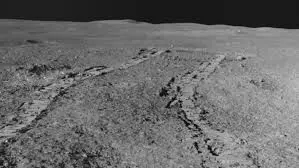Chandrayaan-3 Discovers Sulphur, Silicon and Ancient Craters at Moon’s South Pole
Chandrayaan-3 confirms sulphur at Moon’s south pole, records moonquakes, extreme temperatures, ancient craters, and unveils ISRO’s future lunar plans.
Chandrayaan-3’s Pragyan rover exploring the Moon’s south pole, confirming sulphur and revealing insights into lunar geology and ancient craters.

From the Moon's uncharted south pole, India's Chandrayaan-3 mission continues to provide ground-breaking discoveries. The mission has improved knowledge of the lunar environment, composition, and geology since its historic landing on August 23, 2023.
Sulphur Found for the First Time
For the first time, the Pragyan rover has verified that sulphur is present at the lunar south pole. Key elements such as aluminium, calcium, iron, chromium, titanium, manganese, silicon, and oxygen were also detected by means of sophisticated spectrometers. These results may aid in the investigation of surface processes and the evaluation of the potential for subsurface water ice deposits.
Moonquakes and Seismic Activity
In the south pole region, Chandrayaan-3 has detected more than 250 seismic signals, at least 50 of which are unrelated to rover or lander activity. This is the first seismic data taken from the southern hemisphere of the Moon since the Apollo missions, and it raises the possibility of moonquakes.
The Moon's Extreme Temperatures
The ChaSTE (Chandra's Surface Thermophysical Experiment) probe, which was carried by the Vikram lander, showed extreme temperature changes, from 82 °C on the surface to minus 168 °C only 10 cm below. Sloped regions close to the south pole might contain stable subsurface ice, according to ISRO, improving the likelihood of using lunar resources in the future.
A Better Understanding of the Moon's Early History
The rover discovered evidence of ancient impacts and mantle materials from 4.3 billion years ago by examining rocks and soils from the South Pole–Aitken Basin. This offers a unique glimpse into the Moon's evolutionary past and molten beginnings.
Other Important Findings
- Low-density lunar plasma detection
- Finding an old crater that is 160 km across
- Confirmation of the Moon’s dynamic geological past
The Future Lunar Roadmap of ISRO
By the end of this decade, ISRO is already getting ready for the Chandrayaan-4 and Chandrayaan-5 missions. The long-term strategy consists of:
launching more than 100 new satellites
- establishing a constellation of satellite-based internet
- By 2040, putting an Indian astronaut on the moon
- Nilesh Desai, Director of the Space Applications Centre (SAC), recently confirmed that ISRO has outlined a vision up to 2040. “We estimate that around 103 satellites will be in orbit by 2040, alongside multiple lunar missions,” he said.
With Chandrayaan-3’s continuing revelations, India has firmly established itself as a leader in lunar exploration.

